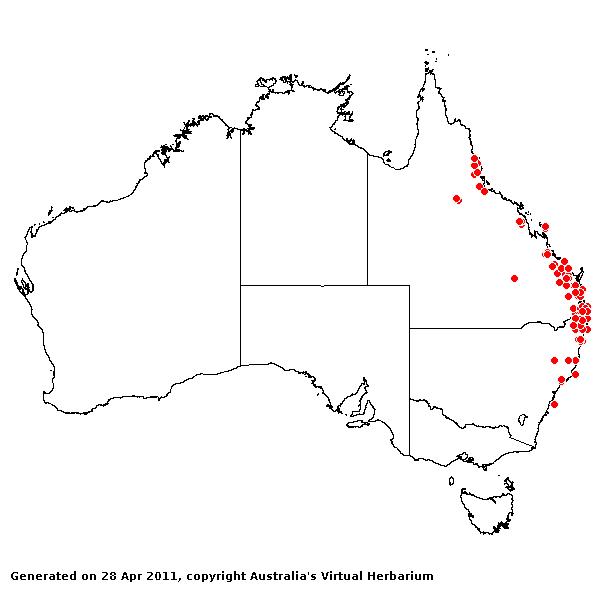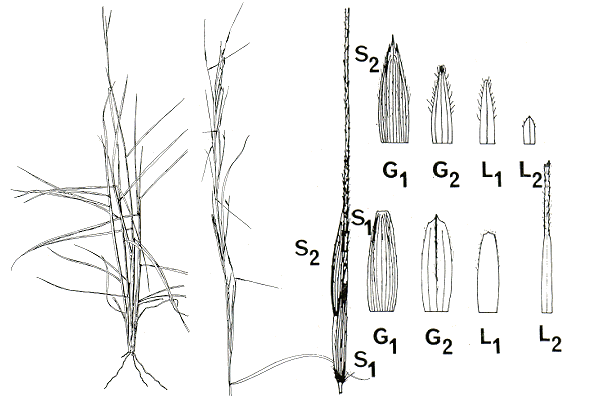Hyparrhenia filipendula (Hochst.) Stapf.
Fl. Trop. Afr. 9: 323 (1918).
Classification. (GPWG 2001) : Subfamily
Panicoideae. Andropogoneae.
Basionym and/or
Replacement Name: Andropogon
filipendulus Hochst., Flora 29(8): 115 (1846).
Type of Basionym or
Protologue Information: HT: Krauss 28, South
Africa: Natal
(B; IT: K, MO-2103102).
Recent synonyms: H. filipendula var. pilosa.
Key references
(books and floras): [1878] G.Bentham, Flora Australiensis 7 (534 as Andropogon
lachnatherus), [1969] E.E.Henty, Manual Grasses New Guinea
(110), [2002] D.Sharp & B.K.Simon, AusGrass, Grasses of Australia,
[2008] S.W.L.Jacobs, R.D.B.Walley & D.J.B.Wheeler, Grasses of New South
Wales (282).
Illustrations:
[2008] S.W.L.Jacobs, R.D.B.Whalley & D.J.B.Wheeler, Grasses of New South
Wales, 4th edn (282).
Habit.
Perennial. Rhizomes present, short. Culms erect, 60–200 cm tall. Lateral
branches simple or branched. Leaves cauline. Ligule an eciliate membrane, 0.5–1
mm long. Leaf-blades 15–30 cm long, 1.5–5 mm wide.
Inflorescence.
Inflorescence compound, composed of rames. Central inflorescence axis 20–90 cm
long. Rhachis fragile at the nodes.
Spikelets.
Spikelets sessile, 1 in the cluster. Companion spikelets pedicelled, 1 in the
cluster. Basal sterile spikelets well-developed, on lower raceme 2 in number.
Companion spikelets developed, containing empty lemmas or male, 5–7 mm long.
Companion spikelet glumes awned. Fertile spikelets 2-flowered, the lower floret
barren (rarely male), the upper fertile, comprising 1 basal sterile florets,
comprising 1 fertile floret(s), without rachilla extension, linear or elliptic
or oblong, dorsally compressed, 5.5–8 mm long.
Glumes.
Glumes dissimilar, firmer than fertile lemma. Lower glume lanceolate,
chartaceous or coriaceous, without keels, 9–11 -nerved. Lower glume surface
glabrous or indumented. Upper glume linear, chartaceous or coriaceous, without
keels. Florets. Basal sterile florets 1, barren, without significant
palea. Lemma of lower sterile floret 100 % of length of spikelet, hyaline, 2
-nerved.
Fertile lemma without
keel, 1 -nerved. Lemma apex dentate, awned, 1 -awned. Median (principal) awn
from a sinus, 30–55 mm long overall, with a twisted column. Palea absent.
Lodicules present. Anthers 3.
Continental
Distribution: Africa, Temperate Asia, Tropical Asia, and Australasia.
Australian
Distribution: Queensland, New South Wales.
Queensland:
Burke, Burnett, Cook, Moreton, Port Curtis, South Kennedy, Wide Bay, North
Kennedy. New South Wales: North Coast, North-Western Slopes,
Central-Western Slopes.
Notes.
Two varieties have been recognised traditionally with glabrous spikelets (var. filipendula,
very rare in Australia) or hairy spikelets (var. pilosa, the form
commonly found in Australia) but the distinction is not worth upholding
(W.D.Clayton in Kew Bull. 30: 579 (1975)).
Fairly widespread in
coastal areas of Qld and NSW, spreading through Malesia to Sri Lanka and
abundant in Africa. Flowers Nov.--June.



